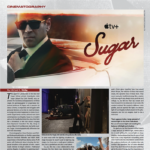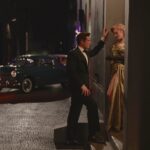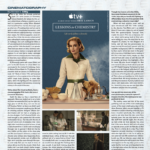We’re looking at the backs of two heads in a moving car, as a boy known as Little rides with a man he just met. The man, played with understated finesse by Mahershala Ali (who won an Oscar for the role), turns his head repeatedly to the silent boy beside him, but Little (Alex R. Hibbert) stoically refuses to speak. We are struck by the distance between them—the gap made even more pronounced by the extended width of the screen.
This is anamorphic format, known colloquially as CinemaScope (though this brand name referred to a lens series not used since the 1960s). It’s a cinematography technique that involves shooting a widescreen picture on 35mm film, using lenses designed for this purpose. Without the anamorphic lens, the widescreen image fills the frame horizontally but not vertically, giving it a “letterbox” appearance with wasted space above and below the image. When an anamorphic lens is used, the captured image fills the frame vertically as well as horizontally, giving it a stretched appearance in production. Later, when the film is projected, the projector’s anamorphic lens corrects the stretched look, and the film fills the entire screen, left to right and top to bottom.
The use of anamorphic format in the film Moonlight, the 2017 Oscar winner for Best Picture, represents a bold choice for director of photography James Laxton, who has risen to near rock-star status in the production world since this $1.5 million independent film took the top statuette. The film earned him an Oscar nomination for Best Cinematography.
He was in production on another film when we tried to catch up with him, but Laxton wrote about his choice to use this format in an October 2016 article in MovieMaker. “Often anamorphic is used on big, blockbuster films—X Men, Star Trek, Transformers—so audiences associate this photographic style with epic scenes and enormous scope. While Moonlight doesn’t have planets exploding, the wide format communicates the force of the characters’ pain and struggle.”

It’s possible that Moonlight is one of the most intimate films ever to use the anamorphic format. The story follows a boy named Chiron (that’s pronounced shy-RONE,) in one of the poorest sections of Miami, Florida, through three critical phases in his life: We meet him as a child, hiding in a crack house to escape neighborhood bullies who have nicknamed him “Little,” and again as a teenager grappling with his confusing attraction to his friend Kevin. In the final chapter, we discover him anew on the other side of his transformation into adulthood. This is no sweeping generational epic, however—we experience one difficult encounter after another through tight shots of characters’ faces, in which director Barry Jenkins never forces dialogue to override the story unfolding in Chiron’s eyes.
The combination of the widescreen technique and the relationship between camera and characters makes for an intense viewing experience, one heightened by Laxton’s use of a single camera throughout the film. His approach, he told Matt Mulcahey of Filmmaker magazine in November 2016, was to give the actors as much time as possible in front of the camera to allow a scene to unfold. “Working with child actors and working with some people who were acting for the first time on screen, we wanted to be able to keep rolling and keep rolling to make sure we give them the space to work the performances out,” he said. “Sometimes on set there’s a momentum that you have when you keep going and going. And sometimes you can keep that momentum by not cutting in between takes and just re-setting.”

Laxton has worked with Morgan Kellum at VER in Los Angeles to put together his gear package. “He’s dedicated to his craft,” said Kellum. “I’ve worked with James for many years—we hooked up originally on some commercial work eight or nine years ago. He is the master of his domain.”
Kellum and VER aid the production by preparing all of the equipment before the show date. The camera, lenses and all the accessories come to VER’s prep facility, where skilled technicians make certain that the entire rig goes together properly and that all of the gear is in working order. “On the day of show, it’s ready to go,” said Kellum. “We have our own quality control process—every cameraperson has their own way of doing things, so it’s up to us to make sure that everything is given to them in the shape it’s supposed to be in, so there are no surprises.”
For Moonlight, Laxton chose the Alexa XT digital camera, which provides a true anamorphic aspect ratio in a 4:3 sensor mode. “Since an anamorphic lens squeezes the Cinemascope 2.39:1 image by a factor of 2, it needs a sensor area with a 1.195:1 aspect ratio,” the Alexa website explains. “Film and the Alexa sensor are tall enough to easily accommodate this … Since film and the Alexa sensor have almost exactly the same dimensions, they exhibit the same angle of view for anamorphic lenses.”
To make the most of this, Kellum says that Laxton chose Hawk V-Lite Prime anamorphic lenses, as well as some Angénieux anamorphic zooms with Hawk adaptors. “I know some cinematographers use the same things all the time, but James is pretty well all over the map,” he said. ““He has a pretty wide gamut; it’s catered to the project he’s working on.”
Laxton explained this choice in Filmmaker. “We chose the Hawks because they provided the most applicable rendering of what we were looking for,” he said. “They’re very sharp lenses and also very contrasty lenses … There’s a trend in film right now to have a low-contrast look, but we wanted to emphasize contrast.”

Miami Light: A Study in Contrast
If you’ve been to Miami, you know the way the light hits you the moment you step onto any street. Hard shadows from the proximity of the sun, sharp outlines of people’s faces, colors that glow beyond the usual spectrum—all of these combine with the soft air and humidity to create a city that is both high and low contrast at the same time. The result is a sense of lax, languid living with short bursts of euphoric bliss.
For this effect, which IndieWire called “an inherent visual tension,” the filmmakers turned to colorist Alex Bickel, who worked with Jenkins and Laxton from pre- to post-production on achieving the look they sought.

Laxton determined that each of the three chapters of the film would have its own look, one that emulated a specific film stock from a different manufacturer. The first chapter would take on the look of a Fuji stock, which “is a little warmer and brings out a lot of texture in the skin tone,” according to Indie-
Wire. The second chapter mirrors an old Agfa stock with heightened cyan in the image highlights, giving the entire chapter an intense, almost turquoise luster. This becomes particularly apparent in the scene at night at the beach, where Laxton shot with the limited available light and added just one custom-created instrument that made the characters pop against the Miami night sky. “Our talented gaffer, Kiva Knight, and our key grip, Anthony Schrader, built a 14-by-14-inch soft box with 36 LiteGear FauxFlo LEDs rigged above half grid diffusion,” Laxton wrote in MovieMaker. “With the FauxFlos, we were able to dim down to a level that gave us just enough exposure to separate our characters, yet still incorporate them into the deep background lights of the city.” They lit the rest of the beach with 4K HMIs and 1Ks “gelled to match color with the sodium vapor lights of the parking lots behind us.”
The third act’s look comes from emulation of a modified Kodak film stock, giving it the brighter greens and high-pop color saturation with which the company once made its fortune. From the streets of Atlanta to a front door in Miami’s housing projects, the result is a heightened reality that enhances the power of the film’s final scenes.
Even with the three different looks, however, Moonlight maintains a visual theme that takes its cues from Miami’s distinctive light. Faces reflect the ubiquitous Florida humidity, glowing with a sheen that defines jawlines, highlights cheekbones and glances off of foreheads. While the city vibrates with bright color, the light aqua ocean tones take over the twilight and the shadowy scenes inside the project apartments.
“When I saw those first test shoot images, I quickly realized James and Barry were really going for it, and this was going to be a visually aggressive movie,” said Bickel to IndieWire. “Barry certainly wasn’t playing it safe with the story, and he didn’t want to play it safe in the visuals. That got me excited.”

The Long Shots
Color and light set the tone for this film, but it’s the long, lingering shots on the actors’ faces that make Moonlight significantly different from other movies about the urban drug culture. Letting a scene happen is not en vogue in Hollywood for such films—the love of the shaky-cam on city streets and rapid-fire series of cuts during action sequences are the trademarks of movies focused on a fast-moving plot, rather than on the development of characters.
In Moonlight, however, the camera almost becomes a character in itself, the silent, supportive friend that Chiron doesn’t have. The camera waits until Chiron can bring himself to speak; it sits patiently in the back seat and allows others to talk; it captures both Chiron and Kevin and emphasizes the distance between them while it holds out for a halted conversation to resume. In a world where no one seems to be on Chiron’s side, the camera becomes the constant. It pulls us into the most intimate moments in Chiron’s life, and it demands our empathy.
This is what garnered an Oscar nomination for James Laxton—as well as Best Cinematography wins from the Film Independent Spirit Awards, the Alliance of Women Film Journalists, the Black Film Critics Circle, the Los Angeles Film Critics Association, the National Society of Film Critics Awards, the New York Film Critics Circle, the Georgia Film Critics Association, and others.
“James likes to be in the background and service the story as best he can,” said Kellum. “You’ll see a lot of interviews with him where he tries to play down what he does. I’ve worked with hundreds of DPs over the years, and James is one of the nicest guys I’ve ever met—an easygoing, quiet personality. I’m glad to have the opportunity to talk about him a little bit.”


